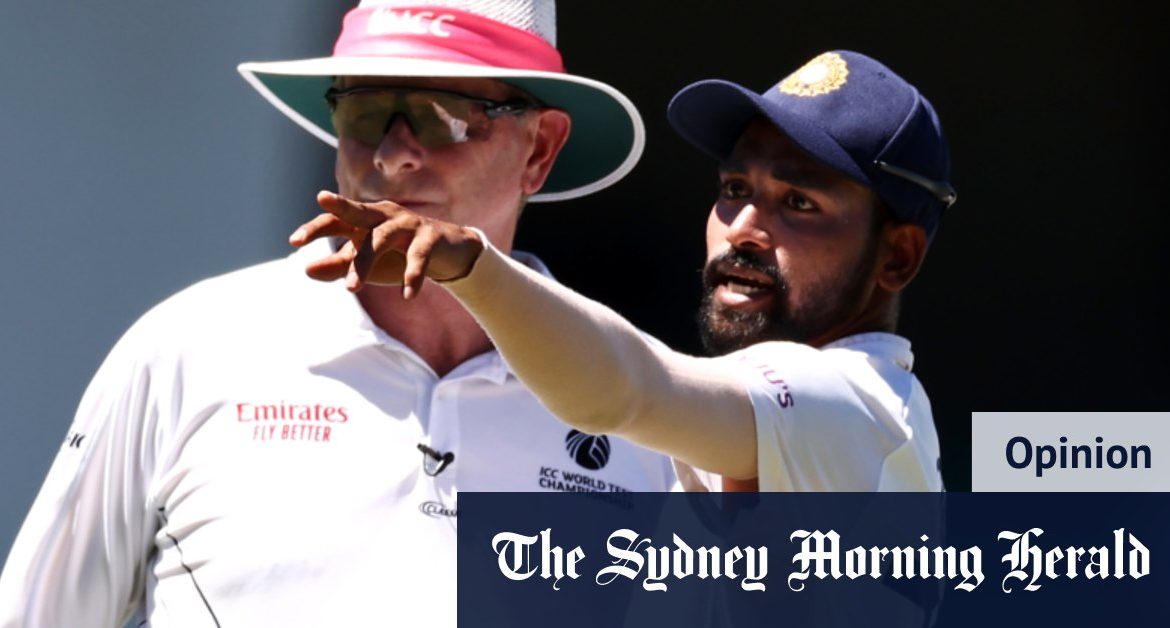Even the Mumbai police commissioner, Shri Param Bir Singh, chimed in, with a Tweet saying: “Colour Of The Jersey – The Only Colour That Should Matter On Field.”
It’s not the first time a Sydney Test has raised hackles on the subcontinent – the India-Australia match in January 2008 was overshadowed by the so called “Monkeygate” episode and triggered a flurry of negative headlines.
Police remove six men from the SCG after more allegations of abuse were levelled by the tourists.Credit:Getty
Indian commentators and fans claimed spinner Harbhajan Singh was unfairly sanctioned after Australian players alleged he called all-rounder Andrew Symonds a monkey. The Indian star claimed he was falsely accused and had instead used the Hindi slur “teri maa ki.” A three-match ban originally handed to Harbhajan by officials was eventually downgraded but, in India, his treatment was widely interpreted as discriminatory.
Aggressive behaviour by Australian players during the match stoked further uproar. Cricket columnist the late Peter Roebuck labelled it the “ugliest performance put up by an Australian side” for decades and called for the captain Ricky Ponting to be fired.
I watched the reaction to the 2008 Sydney Test from the Indian capital, Delhi, where I was working as the South Asia correspondent for The Sydney Morning Herald and The Age. The intensity of the public response was striking.

Andrew Symonds and Harbhajan Singh at the SCG in 2008.Credit:AP
A few days after the Test I accepted an invitation to discuss the fallout from the match on a national television show called Face the Nation. The debate started at fever pitch – one participant said the events at the SCG had “become a national issue and a matter of honour” and the program’s host, high-profile broadcaster Rajdeep Sardesai, declared ties between India and Australia were under threat. Eventually Sardesai crossed to me saying: “As an Aussie in Delhi you must not be feeling too popular, Matt.”
Effigies of Australian players and match officials had been burnt across the country during the previous few days, so I chose my words carefully.
Two years later, a spate of violent attacks on Indian students in Australia again sparked accusations of racism and strained relations between the two nations. Inevitably, cricket became embroiled in that dispute when the Shiv Sena, a Hindu nationalist party with a reputation for street violence, “banned” Australian cricketers from playing Indian Premier League cricket matches in Mumbai in retaliation for student attacks.
Despite the often heated rhetoric in the Indian media, political and strategic ties between Australia and India have strengthened steadily during the past two decades. The Indian diaspora in Australia has grown rapidly in that period, adding new depth to the relationship.

Indian tourists at Featherdale Wildlife Park in Sydney in 2019.Credit:Steven Siewert
But it would be naive and complacent to think controversies like those during the Sydney Test matches of 2008 and 2021 have no consequences. Recent tensions between Australia and its biggest trading partner, China, underscore the need to nurture alternative export markets. India, Asia’s third biggest economy, presents huge opportunities.
Indian historian Ramachandra Guha describes the interest in cricket across the subcontinent as “one of the world’s great popular passions”. That widespread affection for the game makes Australia’s role in international cricket an asset as we forge deeper economic ties with India.
Nations across the world are clamouring for attention in India because of the vast scale and future promise of its fast-growing market. Cricket ensures Australia gets plenty of publicity on the subcontinent and is better known in India than many other countries.
But at the same time, Australian cricketers and the crowds that watch international matches have a disproportionate influence on the way our nation is perceived on the subcontinent. The eleven players that take the field for Australia’s men’s and women’s cricket teams are a window on our nation for millions of Indians. Whether we like it or not, their behaviour – and the actions of spectators – helps to shape impressions about Australia. And that has ramifications way beyond the stadium.
India, for instance, is an important market for our international education sector, a major employer in Australia and our biggest services export. But the widely publicised racist taunts at the SCG could easily discourage Indian families from sending a student to university here.
The political and economic relationship with India is already crucial to Australia and will become even more important over time. But that relationship can do without cricket fans targeting Indian stars with taunts. It can also do without boorish behaviour by Australian cricketers.
Matt Wade is a senior economics writer at The Sydney Morning Herald.
Most Viewed in Sport
Loading







